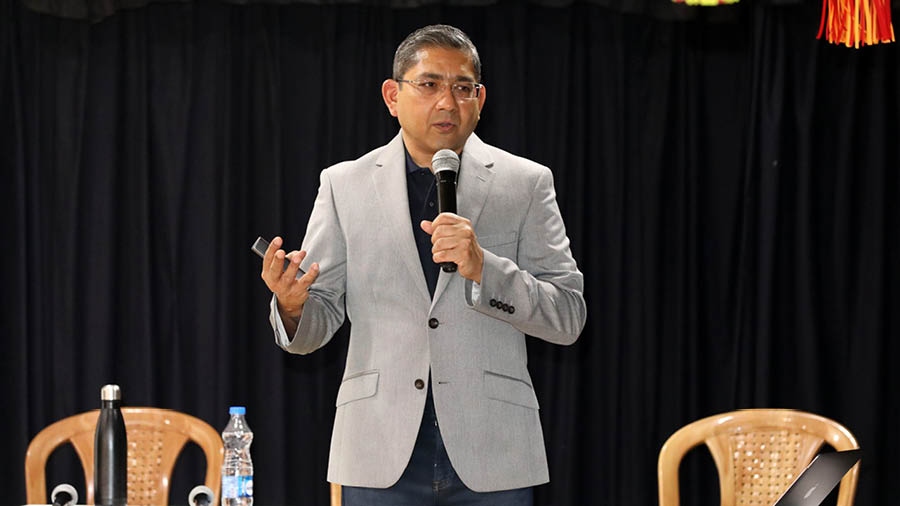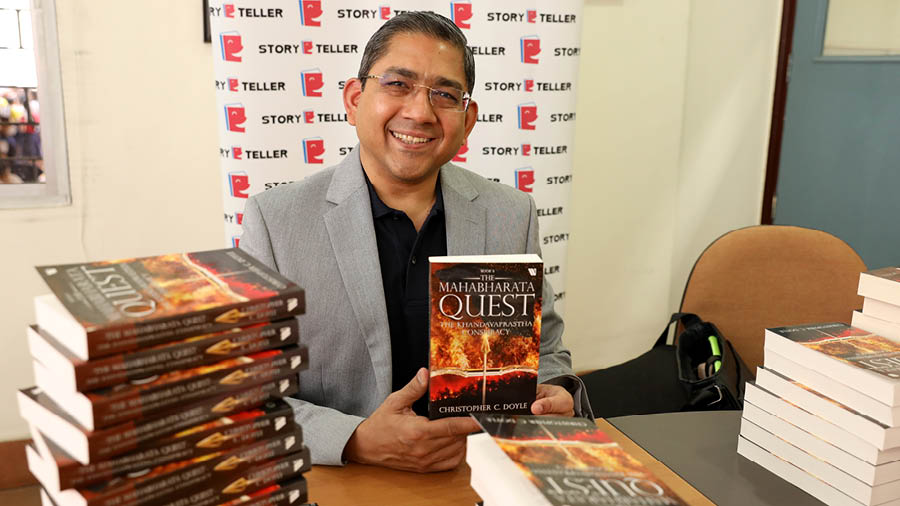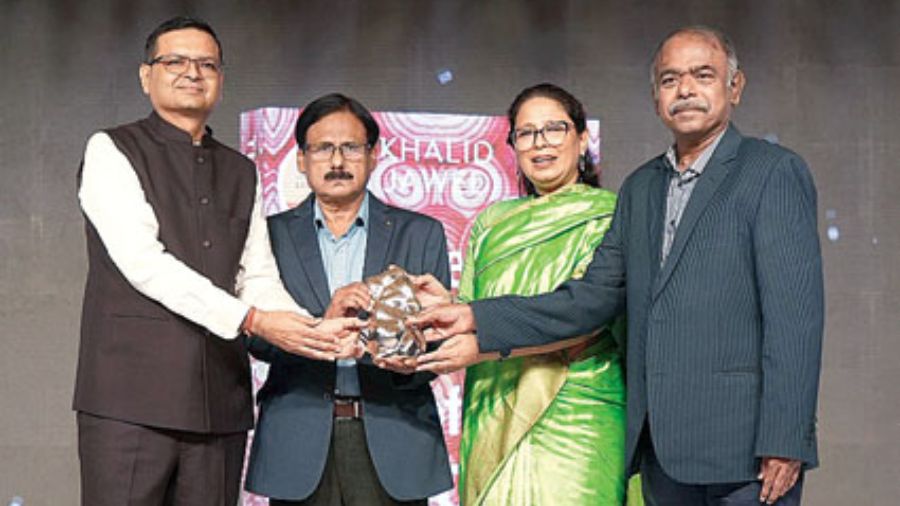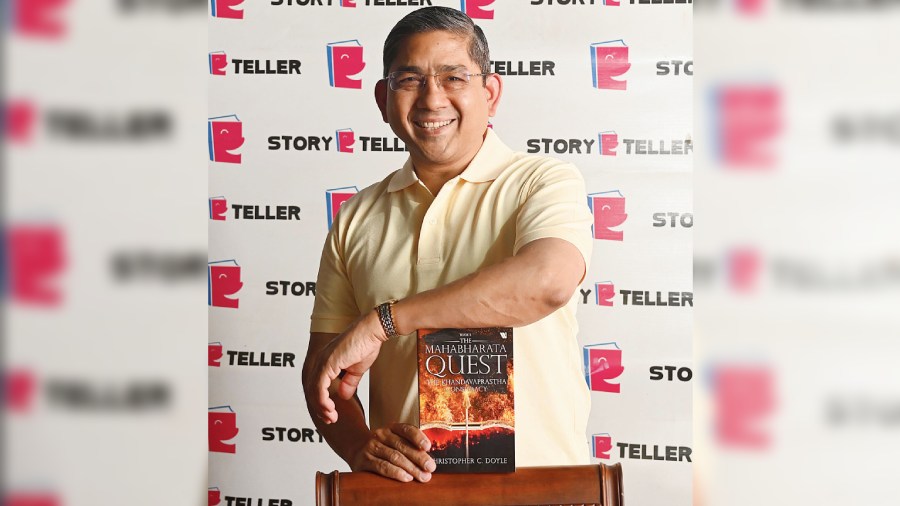Author Christopher C. Doyle was in Kolkata recently for the launch of his latest book, The Khandavaprastha Conspiracy (Westland), the third part in his Mahabharata series. He dropped by at The Storyteller Bookstore, Sushila Birla Girls’ School and The Heritage School to talk about his book.
My Kolkata caught the author in his element at Sushila Birla Girls School post his talk with the students and chatted with him about his book, his writing style and his memories of Kolkata, the city where he studied, lived and worked until some decades ago.
Excerpts from the conversation
My Kolkata: Please tell us something about The Khandavaprastha Conspiracy. Is it a standalone book or is it to be read as a part of the series?
Christopher C Doyle: The book is a complete story by itself. The story starts and ends in this book. There is no link to the previous books. Though I would always recommend that you start with the first book because the characters are the same. When you start with The Alexander Secret and then go to The Secret of The Druids and then come to this book, you connect with the characters more because you actually see the character development happening. I think there’s some charm in reading that as well. Where they were in The Alexander Secret and where they are today, there has been an evolution of character and that’s a deliberate part. I wouldn’t like to have the same character without evolution.
The book itself [The Khandavaprastha Conspiracy] is a biological thriller and it’s a combination of real scientific concepts which I first thought of around 2015-16 when I was researching it. The whole story revolves around what seem to be unrelated mysteries which are somehow connected to a mystery in the Mahabharata. Can the Global Task Force actually find the connections and solve the mystery before the human race is wiped out?
What attracts you towards the Mahabharata?
I think all of us Indians are attracted to the Mahabharata. I have always been fascinated by it even as a child. We also had B.R. Chopra’s famous television series which I think brought at least the Kurukshetra War to a very large audience. So, that was one thing. And then in the Mahabharata itself, there are so many fascinating stories and characters. I mean the Ramayana is a part of the Mahabharata, in summary. When you look at the characters, what really interests me is the fact that the characters seem real and human-like. Even the devas are grey characters. Lord Krishna was divine and he expresses his divinity more than once during the course of the Mahabharata but even he has shades of grey. The Mahabharata has treated everyone with very real human emotions. It’s a fascinating epic. The fact that there are so many mysteries in the Mahabharata. When you are reading it you are wondering what is this all about. Could something like this really have happened?
The events of the Mahabharata have always been seen as mythological episodes. How did you come about using the principles of science to justify them?
I think I have been influenced by a lot of academic research being conducted for the last 50 years, maybe more. Primarily in western mythology, but in the domain of Indian mythology where different aspects of science like astronomy and other pieces of evidence have been put forward. There’s a very interesting consensus that’s emerged as an advanced school of thought which says that behind every mythology in the world, there is some truth. Now what we see today, we may not know what is truth and what is fantasy or what story has been built around it but there could be evidence, there could be an event in the past which actually happened and we have seen it happening in more than one case.
I gave the example of Ashoka in my presentation [to students of Sushila Birla Girls School]. He was thought to be mythological but he was actually a historical king. So that’s what has fascinated me. While we all consider the Mahabharat to be mythological, it could be possible that there was a war between the Pandavas and the Kauravas. Some of the other events, the Samudra Manthan for example, was the subject of The Alexander Secret. In my latest book, I explored the possibility of the Khandavaprastha fire. We traditionally see it as a fire that killed everything in the forest. There’s this incorrect notion that a lot of people have that Khandavaprastha was burnt by the Pandavas to build the Indraprastha which is not correct. I try and correct that perception in the book. I am trying, in my own way, to use fiction and see if I can find a credible explanation for the possible reality behind the mythology.

The author poses with young readers at The Storyteller Bookstore
When it comes to the Mahabharata, there is a myriad of perspectives. How did you pursue your research in order to get a grasp on the epic?
The first thing was to read the Mahabharata and read different translations of the book because I don’t know Sanskrit. For the last 15 years, I won’t say I can read Sanskrit but I can figure out what a shlok means and figure out whether I agree with it or not, the translation. That’s when you get to know the details. What I just talked about the Khandavaprastha, if you actually read the Mahabharata, the chronology becomes very clear that Khandavaprastha was given to the Pandavas as half the kingdom. They went there and built Indraprastha, the city was prosperous and then Agni approached them to burn down Khandavaprastha. It has got nothing to do with the city. It is different from the assembly hall of the Pandavas that was built on top once Khandavaprastha was destroyed. That’s what I explore in the book, was there a different intention behind the whole forest fire?
The book spans different timelines and follows a non-chronological format. What is the one challenging aspect of going back and forth with timelines?
I think this book is a bit more complicated because It goes all over the place. Whereas the other books in the series are not so much back and forth. I think for The Alexander Secret and The Secret of The Druids, it wasn’t that challenging. But in this one, I think keeping track of different dates, making sure that they matched fictional events required attention to detail. For example, if something happened in 1817, I had to make sure my story matches the real-life circumstances because I was using real facts from history. If I say a character went to London in 1817, for example, then I have to make sure that the character did actually go to London. It’s there in the history books. If I say, this person went to Oxford University, I’ll make sure that the historical records show that happens. Then I’ll link it fictionally. That is challenging because I am not a structured writer. It is a challenge because at times I write something and then I realise this is not aligning to the facts and then I have to rewrite the sections.
What does your writing process look like? Is there a particular time during the day that you write?
I am a very chaotic writer so I don’t have a structured approach to writing. I like to write the way I like to read, let me put it that way. So, there are times when I surprise myself. I mean in one of my books, I killed off a character which I didn’t expect to happen. It was not planned. I was shocked. I wondered whether I should change it or leave it there. I finally decided against it. If I was shocked, then my readers are going to get a surprise too. So I left it there. It was totally unplanned. I also run a business aside from writing. It’s difficult to have a structured approach to writing. What I do is when I can, I try and wake up early around 4 to 4.30am and the first two-three hours is when I do either research or writing. But it doesn’t happen always.

Doyle addresses the audience at Sushila Birla Girls School
When can we expect the next book from you?
I am hoping to release the third book, The Pataal Prophecy, hopefully, next year
Quick takes
One book that you keep going back to
The Mahabharata
Your favourite character from the Mahabharata and why?
I don’t think I have really thought much about it. I like all the characters.
What is Christopher reading right now?
Right now, I don’t have time to read anything else, but I’m doing a lot of research for the next book in the series.
When not reading what would we find you doing?
Working on my business
One memory about the City of Joy you can never forget?
Oh, I spent two years studying over here at IIM Calcutta from 1987-89. Those two years were amazing . It’s still the same. I mean this side of Kolkata, Salt Lake of course has completely changed. But I don’t find a lot of change in the south [Kolkata]. You have the same taxis and all. In fact, a few years ago, I had come with my family for a holiday and I went to a restaurant close to my office. I have also lived and worked in Kolkata. My office was in Park Circus and I was living on Camac Street. So, on Lower Circular Road, I think, there was a restaurant called The Golden Dragon. I used to go there for lunch quite often. What I found very interesting is when I came back after so many years, the staff there was still the same. It was nice, seeing the same faces, older of course. Also, the food hadn’t changed.


